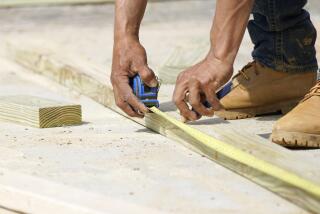Would We Remodel Again? Yes, But . . .
When my wife started talking about adding onto our home, I thought we would be better off if we found a new place with the things she wanted. It would mean moving, which to me is an experience akin to having a root canal. But I had heard all the horror stories about remodeling. In fact, I had not encountered anyone who had been through a major renovation who offered any advice except, “Don’t do it!”
Having now been through both, I’m not sure which is worse.
We had been renovating our small, three-bedroom home ourselves room by room. Paint, wallpaper and five-gallon tubs of spackling compound were applied liberally. It was now time to tackle the kitchen, laundry room and small half-bath.
My plan was simply to replace the appliances and plumbing fixtures, refinish the kitchen cabinets and redo the floors.
My wife envisioned adding a second story. She wanted, at a minimum, to “do something about” our smallest bedroom, located behind the kitchen. We searched for a compromise.
After my wife had spent many months sketching floor plans, we settled on a concept and called in an architect.
The plans called for adding out over the garage built into the hillside below the house and reworking the existing kitchen, bedroom and bathroom. Adding out over the garage gave us enough extra room to turn that smallest bedroom into a master suite, while doubling the size of the kitchen. We also added a large deck across a ravine in the back of the house.
The first hitch occurred when we tried to get the building permits. It had escaped the architect (and a city planning department office as well) that there had been a recent zoning change that affected setbacks in hillside areas.
Our garage is built at street level, and is set back only inches from the property line. Nearly all the garages on our side of the street are the same. The new regulation required a 10-foot setback for traffic safety reasons, but it didn’t seem as if that should apply to the addition over the garage. More than two months of paperwork and phone calls finally got us the zoning variance we needed.
By the time we were ready to start, we had collected the names of six contractors who were recommended by friends or our architect, who suggested that we get preliminary bids from all six based on the schematics, or layouts, of the plans.
The highest bid was double the lowest bid, which was a much larger range than we had expected. We eventually got the list down to two, and when the references for both checked out, we selected the one that could start the earliest.
About a third of the existing house had to be demolished wall to wall. The two doorways leading to the new construction were boarded up the first day and stayed that way for the first half of the job. It kept us physically separated from much of the dirt and commotion.
Being without a kitchen for nearly four months seemed like an adventure at first. We rolled the refrigerator into the dining room and set up the microwave oven on a small table.
After the first week, we got tired of doing dishes in the bathroom sink and switched to paper plates and plastic silverware.
After the first month, we had tried nearly every frozen entree we could find. We also ate a lot of pizza, deli and Chinese, and became regulars at several local restaurants. It was not fun.
There were so many things to select: plumbing and lighting fixtures, carpeting and tile, appliances, colors for paints and stain. We could barely make the decisions fast enough to keep up with the pace of construction.
Most of the crews seemed to work very quickly. Someone was there every Saturday, and even a few Sundays after the work moved inside. By the end of the fourth week, all of the framing was complete. The rough electrical and plumbing had been installed, and the furnace ducts were all hooked up. By the 10th week, painting had started and most of the kitchen and bathroom cabinets were installed.
At the end of week 14, the projected completion date, there was still much to be done. The kitchen and bathroom tile was only half in. Nearly every subcontractor had some work left to finish.
The lack of on-site supervision allowed some workmen to undo the work of others. One room received three final coats of paint due to communication mix-ups. There was never more than one person working at the same time during the final phase of construction, and the job dragged on. At the end of week 24, we finally finished.
One of the lessons we learned is that it is important to get absolutely everything on the plans. Many details that the contractor said were “no problem” in early conversations became points of contention as the job dragged on and costs mounted.
The biggest problem we encountered was a lack of supervision of the project. The contractor had originally promised an on-site superintendent. After the job started, he decided it was too small to warrant having someone there all the time. Consequently, there were three people who were each responsible part of the time. Many specific tasks were redone due to the ensuing communication problems, mostly at the contractor’s expense. The primary penalty we paid was a significant delay in completion.
Three months late, but within a few percent of the budget, we finally finished. It was a stressful experience, not recommended for couples with a shaky relationship.
Would we do it again? Probably, but we’d do a few things differently:
--The plans would have more detail included before the start of construction.
--All the choices would be made upfront.
--The next contractor will have to include in writing his plans for on-site supervision.
The biggest difference, however, is that we’d move out of the house during construction. A clean, quiet, dust-free apartment, complete with a real kitchen, would easily be worth the cost.
More to Read
Sign up for Essential California
The most important California stories and recommendations in your inbox every morning.
You may occasionally receive promotional content from the Los Angeles Times.






